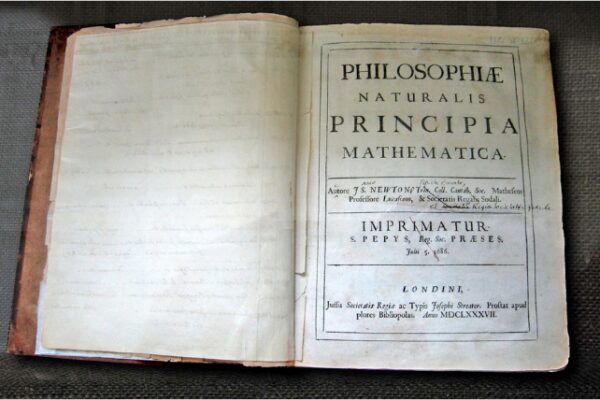
Posted on 02/20/2025 12:00:36 PM PST by Red Badger
When Isaac Newton inscribed onto parchment his now-famed laws of motion in 1687, he could have only hoped we'd be discussing them three centuries later.
Writing in Latin, Newton outlined three universal principles describing how the motion of objects is governed in our Universe, which have been translated, transcribed, discussed and debated at length.
But according to a philosopher of language and mathematics, we might have been interpreting Newton's precise wording of his first law of motion slightly wrong all along.
Virginia Tech philosopher Daniel Hoek wanted to "set the record straight" after discovering what he describes as a "clumsy mistranslation" in the original 1729 English translation of Newton's Latin Principia.

Newton's own copy of Principia with his hand-written corrections for the second edition, now housed in the Wren Library at Trinity College, Cambridge. (Isaac Newton/CC0/Wikimedia Commons) Based on this translation, countless academics and teachers have since interpreted Newton's first law of inertia to mean an object will continue moving in a straight line or remain at rest unless an outside force intervenes.
It's a description that works well until you appreciate external forces are constantly at work, something Newton would have surely considered in his wording.
Revisiting the archives, Hoek realized this common paraphrasing featured a misinterpretation that flew under the radar until 1999, when two scholars picked up on the translation of one Latin word that had been overlooked: quatenus, which means "insofar", not unless.
To Hoek, this makes all the difference. Rather than describing how an object maintains its momentum if no forces are impressed on it, Hoek says the new reading shows Newton meant that every change in a body's momentum – every jolt, dip, swerve, and spurt – is due to external forces.
"By putting that one forgotten word [insofar] back in place, [those scholars] restored one of the fundamental principles of physics to its original splendor," Hoek explained in a blog post describing his findings, published academically in a 2022 research paper.
However, that all-important correction never caught on. Even now it might struggle to gain traction against the weight of centuries of repetition.
"Some find my reading too wild and unconventional to take seriously," Hoek remarks. "Others think that it is so obviously correct that it is barely worth arguing for."
Ordinary folks might agree it sounds like semantics. And Hoek admits the reinterpretation hasn't and won't change physics. But carefully inspecting Newton's own writings clarifies what the pioneering mathematician was thinking at the time.
"A great deal of ink has been spilt on the question what the law of inertia is really for," explains Hoek, who was puzzled as a student by what Newton meant.
If we take the prevailing translation, of objects traveling in straight lines until a force compels them otherwise, then it raises the question: why would Newton write a law about bodies free of external forces when there is no such thing in our Universe; when gravity and friction are ever-present?

The International Space Station travels in a curved orbit due to Earth's gravity. (3DSculptor/Canva) "The whole point of the first law is to infer the existence of the force," George Smith, a philosopher at Tufts University and an expert in Newton's writings, told journalist Stephanie Pappas for Scientific American.
In fact, Newton gave three concrete examples to illustrate his first law of motion: the most insightful, according to Hoek, being a spinning top – that as we know, slows in a tightening spiral due to the friction of air.
"By giving this example," Hoek writes, "Newton explicitly shows us how the First Law, as he understands it, applies to accelerating bodies which are subject to forces – that is, it applies to bodies in the real world."
Hoek says this revised interpretation brings home one of Newton's most fundamental ideas that was utterly revolutionary at the time. That is, the planets, stars, and other heavenly bodies are all governed by the same physical laws as objects on Earth.
"Every change in speed and every tilt in direction," Hoek mused – from swarms of atoms to swirling galaxies – "is governed by Newton's First Law."
Making us all feel once again connected to the farthest reaches of space.
The paper has been published in the Philosophy of Science.
An earlier version of this article was published in September 2023.
Pinggg!..............
“We” who kimosabe?
Clumsy article. Give the phrase. Give the usual translation. Give the proposed real translation. That’s not very hard, but that’s not what she did so far as I can see.



Agreed. Amazing how often “clarifying” arguments are themselves manifestly unclear.
I’m fairly scientifically literate but this article didn’t teach me anything. All I can say is we’ve done pretty well with the interpretation used for the past 300 years, so any alternative reading needs to be fully justified.
But the science is surely settled /sarc
Look in the dictionary for the definition of “Pedantic” and you’ll find a picture of Daniel Hoek.
CC
Old translation: "Every body continues in its state of rest or uniform motion in a straight line unless it is compelled to change that state by forces impressed upon it."
Andrew Motte's 1729 translation rendered Newton's "nisi quatenus" as unless instead of except insofar, which Hoek argues was erroneous.
New translation: “Every body perseveres in its state of being at rest or of moving uniformly straight forward, except insofar as it is compelled to change its state by forces impressed.”
Thanks.
Not every literal translation is necessarily the correct one. It is possible that the meaning of one language is better represented by slightly different words in another language.
I had one of those ball things back in the 70s
I thought about making one with silver balls from nwtm back in the 2010s and even bought the balls, but I forgot
thanks
Proves a very important philosophical point.
Silly people say “Trust the Science!”
But science is inductive reasoning. It’s a “best case” scenario, which lasts as long as we don’t find evidence to the contrary. It’s the “problem of induction.”
And we know that even Newtonian physics, which was assumed to be ironclad “truth” for 300+ years, isn’t really 100% true.
#3 F=d/dt(mv)=mdv/dt+vdm/dt
I think it’s sumtin like dat.
bkmk
Newton’s first law of motion states that an object at rest will remain at rest, and an object in motion will continue moving at a constant speed in a straight line unless acted upon by an external force. This principle is also known as the law of inertia.
—
Now:
Newton’s first law of motion states that an object at rest will remain at rest, and an object in motion will continue moving at a constant speed in a straight line insofar acted upon by an external force. This principle is also known as the law of inertia.
Every so often, God sends us a genius to explain things and redirect our attention.
DaVinci, Newton, Einstein, et al.
It’s about time for another one to come along...........
as we’ve recently learned that Up is Down, and Light is Dark
Disclaimer: Opinions posted on Free Republic are those of the individual posters and do not necessarily represent the opinion of Free Republic or its management. All materials posted herein are protected by copyright law and the exemption for fair use of copyrighted works.